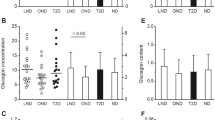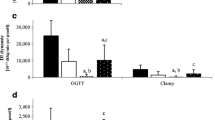Abstract
Adequate metabolic control is central to the concept of islet transplantation, but has received limited attention. We studied metabolic control in 8 dogs at 6–9 months after intrasplenic autografting of ∼25% of the normal mass islets – as compared to 30 controls. A similar posttransplant reduction to ∼25% of the insulin secretory capacity as assessed by intravenous arginine stimulation during 35 mM glucose clamps, mirrored the reduction of the islet mass. Postprandially, in contrast, the insulin response had increased to 140% in the islet recipients – with a concomitant rise of glycemia to ∼8.5 mM. Posttransplant, the insulin secretory capacity correlated both with the index of insulin action (which averaged 55% of the normal value) as assessed by euglycemic hyperinsulinemic clamps, and – inverse – with the postprandial glucose excursions. Because insulin action did not correlate with postprandial glucose, the insulin secretory capacity appears to be the primary determinant of the impaired glucose tolerance. Marked postprandial hyperglucagonemia, and a virtually absent pancreatic polypeptide response in the grafted animals, may also have contributed to the impaired glucose tolerance. Posttransplant, infusion of a physiological dose of the gut hormone glucagon-like peptide-1 during 8.5 mM glucose clamps – mimicking the postprandial glycemia – potentiated glucose-stimulated insulin 175%. Thus, after transplantation of a suboptimal islet mass, postprandial glucose excursions are restrained by hyperglycemic potentiation of the entero-insular axis, which may account for the difference in the insulin response to the intravenous and oral challenges. Because, the insulin secretory capacity reflects the islet mass and appears to be the major determinant of glucoregulation, transplantation of a larger islet mass may allow near-normal glycemic control.
Similar content being viewed by others
Author information
Authors and Affiliations
Rights and permissions
About this article
Cite this article
van der Burg, M., van Suylichem, P., Guicherit, O. et al. The relative contribution of insulin secretory capacity, insulin action, and incretins to metabolic control after islet transplantation in dogs. J Mol Med 77, 104–106 (1999). https://doi.org/10.1007/s001090050312
Issue Date:
DOI: https://doi.org/10.1007/s001090050312




